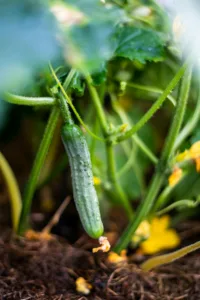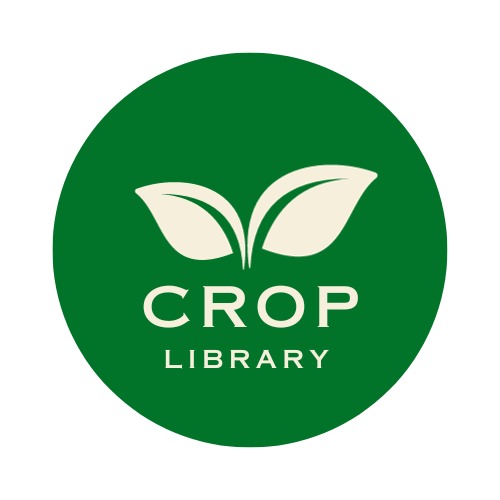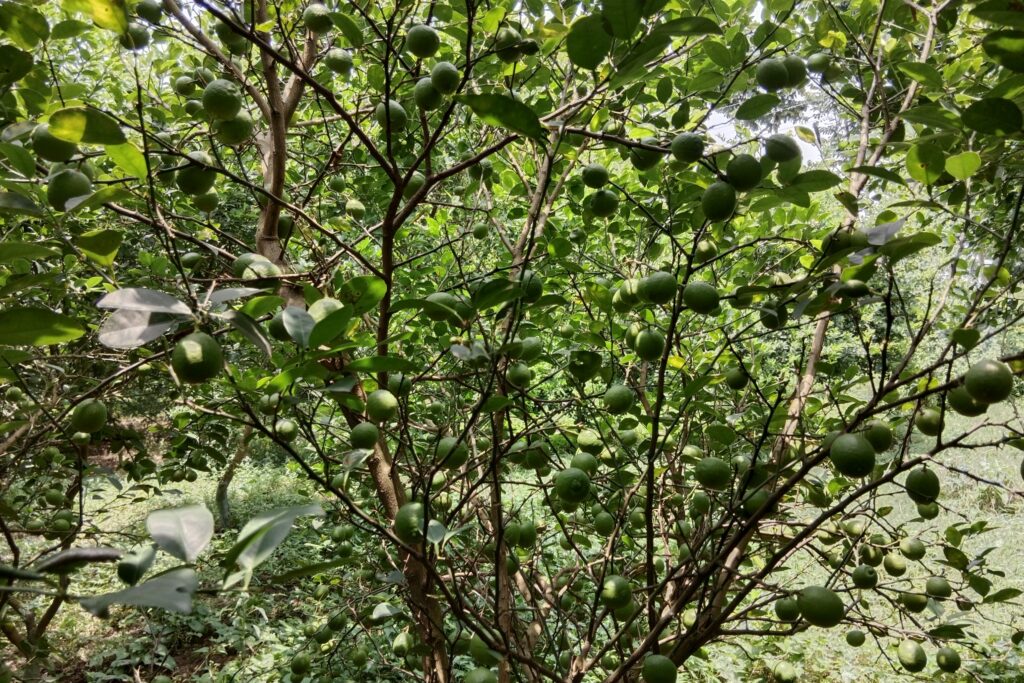What is Cucumber?
Cucumbers (Cucumis sativus L.) belong to the Cucurbitaceae family and are an essential vegetable for consumption. Originating from the Asian continent, particularly North Asia, though some experts suggest an Asian origin.

These plants are creeping vines that can grow up to 90 cm long. The spiraling hairy vines and tendrils originating from the axils enable the plant to climb on supporting structures. The root system is generally shallow, with lateral roots extending further than the vine.
It’s beneficial to apply fertilizer to your cucumber plants regularly for the best-tasting fruits and healthy plants. They require moderate nitrogen and high phosphorus and potassium. An organic plant food with a lower first number than the last two (e.g., 3-4-6) is ideal. Keeping plants well-watered helps prevent bitter-tasting cucumbers.
Cucumbers are sensitive to high salt concentrations at their roots, which occurs with higher doses of soluble mineral fertilizers. It’s better to use organic fertilizers with a slower and more balanced nutrient release, along with additional organic substances to feed soil microorganisms, instead of mineral fertilizers.
Understanding cucumber’s nutrient needs
Cucumbers are very demanding plants that need lots of water and nutrients to produce a good crop. Cucumbers are a classic salad crop and a major source of vital vitamins and minerals for people. They are low in energy but rich in water content, which makes them a healthy choice due to their cooling effect and several health benefits, including reducing constipation, jaundice, and indigestion. They are especially essential in greenhouse farming, where it is one of the most significant types of production.
Cucumbers require significant levels of macro and micronutrients to produce commercially sustainable yields. Cucumber fertilizer schedules with proper doses of potash, phosphate, and nitrogen are essential for a big impact on the amount and quality of cucumber production. Since fertilization has a significant impact on both plant longevity and productivity, it is necessary to develop healthy and fruitful cucumber plants. When it comes to giving cucumber plants nutrition, there are three crucial periods: just after planting, throughout the first six to eight weeks of growth, and right before they start to bear fruit. Cucumber cultivation productivity and overall success are largely dependent on timing and fertilizer technique. Cucumber plants typically require nitrogen, phosphorus, potassium, calcium, and sulfur to flourish.
Here is the list of major nutrients needed:
Compost
Compost is a completely natural, balanced, slow-release fertilizer that works best. Packed full of helpful organisms and abundant nutrients. Most importantly, compost helps to keep the soil moist, which is necessary for seed germination and quick development. Fertilizers like FYM, Poultry manure, and Vermi Compost are organic fertilizers that increase yield.
Biofertilizer
Bio-fertilizers offer an excellent alternative to chemical fertilizers. These preparations are carrier-based and contain effective strains of microorganisms in sufficient quantities, particularly useful for nitrogen fixation in the roots. They have been proven to enhance soil fertility conditions. The use of Azotobacter biofertilizer has shown promising results, with all parameters demonstrating higher values compared to the control, indicating improved plant growth and nitrogen provision. Remarkably, even a small dose of biofertilizer can yield desirable results, as each gram of the carrier contains at least 10 million viable cells of a specific strain.
Biofertilizers contain living microorganisms that penetrate the rhizosphere, or the inside of the plant, by applying them to soil, plant surfaces, or seeds. This increases the host plant’s supply of primary nutrients and promotes growth. They contribute to the enrichment of nutrients through organic processes such as phosphorus solubilization, nitrogen fixation, and the synthesis of growth-promoting compounds. To add organic matter and nutrients to the soil, mix in compost or well-rotted manure.
Inorganic fertilizer
Nitrogen (N)
Nitrogen was administered on the farm in the form of urea, split into two doses. Half of it was applied during planting, and the remaining half was applied during the flowering stage. Phosphorus and potassium were applied during sowing, using di-ammonium phosphate and muriate of potash respectively.
Nitrogen is a crucial nutrient that enhances vegetative growth, development, and fruit yield. It plays a central role in chlorophyll synthesis and is an essential component of various compounds such as amino acids, proteins, nucleic acids, porphyrins, flavins, pyridines, nucleotides, enzymes, coenzymes, and alkaloids, all of which contribute to plant growth.
The most well-known and often utilized nitrogen fertilizers are calcium nitrate, ammonium nitrate, urea, and ammonium sulfate. onium nitrate, urea, and ammonium sulfate.
Phosphorus(P)
Phosphorus is vital for vegetable crop production. It enhances shoot hardiness, increases fruit size and quality, regulates photosynthesis, governs various physiological, and biochemical processes, and aids in root enlargement. Farmers typically incorporate all the necessary phosphorus before planting.
Potassium (K)
Potassium is necessary for several processes in plants, such as the metabolism of carbohydrates, the activation of enzymes, the regulation of osmotic flow, and the effective use of water. It facilitates the translocation of nutrients, protein synthesis, and the intake of nitrogen. It also helps to improve the quality of the fruits or vegetables and lessen some plant illnesses.
Higher doses should be applied during the vegetative stage and from flowering initiation to the first picking. Conversely, potassium is primarily required 30 to 55 days after sowing, with the plant needing maximum amounts during the final stages (last 10-20 days) and fruit enlargement.
Calcium (Ca)
Cucumber is a very productive vegetable crop that has a significant economic impact. It is particularly vulnerable to hypoxic stress. During hydroponic culture and waterlogging, plants frequently experience hypoxic stress. Exogenous calcium supplementation improved the fruit quality and biomass of hypoxia-challenged cucumbers while simultaneously raising stomatal conductance and net photosynthesis rate.
Sulfur (S)
Sulfur’s primary role in plants is as a fundamental component of the amino acids cystine, cysteine, and methionine. It also plays a role in the synthesis and operation of numerous coenzymes.
Cucumber Fertilizer Schedule
There are three crucial moments for providing cucumber plants with nutrients. The first is during planting. The second is within the first six to eight weeks of their growth in the soil. The third and last is as they start to fruit. Apply a dose of 100:50:50 kg NPK / ha throughout the cropping period. At sowing time, apply one-third of the Nitrogen dose along with potassium and Single superphosphate. One month after sowing, during the early stage of vein production, apply the remaining dose of fertilizer.
Pre-planting
Incorporating slow-release fertilizers at final land preparation gives a crop a better start for good growth by supplying the necessary nutrients.
- Compost
Apply @ 12 tones/ha.
- Azotobacter
Apply @2 kg/ha which increases the vine length, earliness in flowering, yield, and yield component.
- Phosphorus Solubilizing Bacteria (PSB)
Apply @2 kg/ha which increases the vine length, earliness in flowering, yield, and yield component.
- Potash mobilizing Bacteria
Apply @2 kg/ha which increases the vine length, earliness in flowering, yield, and yield component.
At planting
When planting cucumber seedlings apply the following nutrients as basal dose:
- Nitrogen (N)
Apply @ 35 kg/ha (1/3rd as basal).
- Phosphorus (P)
Apply @ 50 kg /ha (full dose as basal).
- Potassium (K)
Apply @ 50 kg/ha (full dose as basal).
Crop Establishment Stage (2 weeks after planting).
Apply Nitrogen (N) @ 35 kg /ha.
Vegetative Stage (leaves and vine grow) (4-6 weeks after planting)
Cucumbers have varying nutrient needs throughout their growth stages, requiring more nitrogen during vigorous growth. Apply nitrogen-rich fertilizer to support vine growth and leaf expansion.
Apply Nitrogen (N) @ 35 kg/ha.
Flower initiation to first picking
Once cucumber plants begin flowering, using a fertilizer specifically designed for them, high in phosphorus and potassium, is the best option. As soon as the first flowers appear, the plants require increased phosphorus and potassium levels to promote further flowering and subsequent fruiting. A high-potassium fertilizer, such as cucumber feed or a balanced mix including potassium, can be applied according to instructions.
Apply NPK (0:52:34) @ 3 gm per liter of water and spray.
Another crucial point for fertilizing is when cucumber plants start to produce their first flowers are calcium (Ca). At this stage, application of calcium is crucial for quality fruit. In addition, a weekly application of liquid, high-potassium fertilizer will encourage healthy flowering and fruiting.
Harvesting stage
Apply NPK (0:0:50) @ 3 gm per liter of water and spray.
How to Apply Fertilizer to Cucumber?
Dig a hole and place the recommended amount of fertilizer at the bottom. Cover it with soil to prevent direct contact with the roots. Then, side-dress your cucumber with fertilizer every three to four weeks throughout the season.
To side-dress cucumber, use the tip of a hoe to create a shallow furrow around the plant, approximately 12-15 cm from the stem. Sprinkle 15-21 ml of fertilizer into the furrow for each plant, then cover it with soil and mulch. Be careful not to get fertilizer on the leaves or stems. Water thoroughly after feeding to evenly distribute the fertilizer to the roots.
Another option is to use water-soluble fertilizer, which is often easier to apply, especially for cucumbers in containers. Apply the fertilizer every one to two weeks during the season by mixing it in a watering can at a rate of about 4 ml per liter of water. Avoid applying it in extremely dry or hot weather.
FAQs
Q1. Why are my cucumber leaves turning yellow?
Cucumber leaves may turn yellow due to various factors:
- Nutrient deficiency
If the crop faces a deficiency of nutrients like nitrogen (N), Magnesium (Mg), and Potassium, turn your cucumber leaves yellow.
- Overwatering or Underwatering
Overwatering or underwatering can stress the plants, leading to yellowing leaves.
- Insect and Pest damage
Leaf discoloration can also be caused by diseases like powdery mildew or pests like aphids.
- Natural crop cycle
As the plant grows, older leaves naturally turn yellow and fall off. Finding the exact cause is essential to treating the problem and providing the right care.
Q2. How to plant cucumber seeds?
Prior to sowing cucumber seeds, select a sunny location with well-draining soil. Loosen the soil and incorporate the compost into it to prepare it. For five to six hours, soak the cucumber seeds in water. Next, immediately sow the seeds, spacing them 12 to 24 inches apart and planting them 1 inch deep in the ground. Give the seeds regular watering and keep the soil consistently moist. A trellis can be used to support vining varieties. To keep the plants moist and stop weed growth, mulch the area surrounding them. As previously discussed in the text, treat the seedlings with a balanced fertilizer once they have several leaves.
Q3. When to pick a cucumber?
Although they take a long time to mature, cucumbers can be harvested in 50 to 70 days. Selecting ripe cucumbers at the right moment guarantees that they are bitter-free and sweet. Cucumbers lose their fresh flavor if they are kept on the vine for an extended period because they become bitter. Harvesting the fruits when they ripen is crucial since they ripen at different periods. This often occurs eight or ten days following the bloom of the first female flower. Cucumbers should be picked as soon as possible because yellowing is an indication that they are past their best.
Moreover, when a cucumber reaches 8 to 12 inches in length, it’s ready to be harvested. A ripe cucumber will have soft seeds; you can check this by plucking and lightly pressing a cucumber. You will need to harvest your cucumbers at different stages of maturity, though, if you desire smaller or larger ones.
In addition, look for dull, dark green skins on cucumbers when choosing them; these indicate ripeness and good flavor. Cucumbers that have a glossy exterior are probably not fully ripe. You can pick ripe cucumbers while they’re still green because they’ll also have slightly softer skin. Cucumbers are past their best once they begin to turn yellow.



Pingback: How do you increase the yield of a cucumber? 11 Tips -